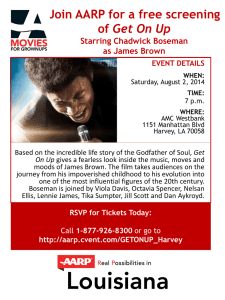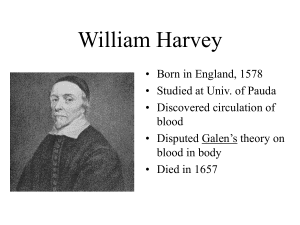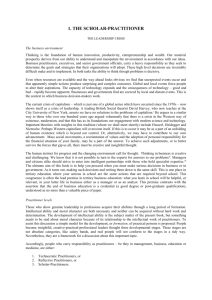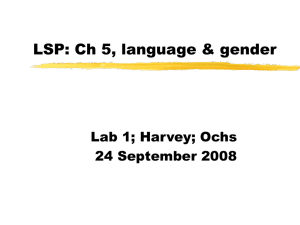William Harvey sources
advertisement
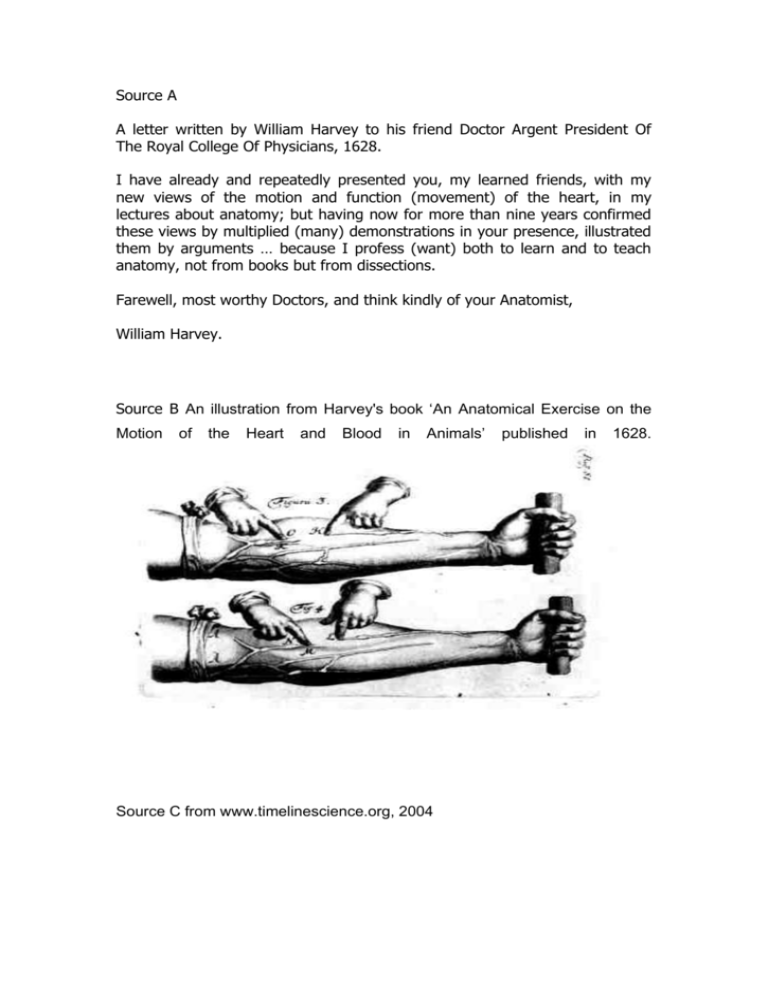
Source A A letter written by William Harvey to his friend Doctor Argent President Of The Royal College Of Physicians, 1628. I have already and repeatedly presented you, my learned friends, with my new views of the motion and function (movement) of the heart, in my lectures about anatomy; but having now for more than nine years confirmed these views by multiplied (many) demonstrations in your presence, illustrated them by arguments … because I profess (want) both to learn and to teach anatomy, not from books but from dissections. Farewell, most worthy Doctors, and think kindly of your Anatomist, William Harvey. Source B An illustration from Harvey's book ‘An Anatomical Exercise on the Motion of the Heart and Blood in Animals’ Source C from www.timelinescience.org, 2004 published in 1628. Harvey carried out many experiments, both dissections and experiments on animals. When Harvey removed the beating heart from a living animal, it continued to beat, which showed it was a pump. Source D from www.timelinescience.org, 2004 Harvey also used mathematics to prove that the blood was not being consumed. Removal of the blood from human cadavers (dead bodies) showed that the heart could hold roughly two ounces of blood. By calculating the number of heartbeats in a day and multiplying this by two ounces, he showed that the amount of blood pumped was far greater than the amount that the body could possibly make…To Harvey, this showed that the teaching by Galen that the blood was being consumed by the organs of the body was false. Source E from ‘The Greatest Benefit to Mankind: A Medical History of Humanity’ by Roy Porter, a medical historian, written in 1999. The fiercest attack on Harvey came from Jean Riolan the Younger (15801657), the leading supporter of Galen in the University of Paris. Riolan realised that Harvey’s ideas about the circulation of the blood had the potential to destroy Galen’s ideas. It would mean, for example, that that liver was no longer the blood-making organ, and once the liver’s function was questioned, what else would not be questioned? Even Galen’s treatments based on the Four Humours would be challenged, because the idea about bleeding had been undermined (shown to be wrong): what price all the old rules about the correct places to bleed if the same blood were streaming round the body? Source F from ‘Medicine Through Time’, written by Joe Scott and Christopher Culpin, 1996 To many 17th century doctors, the things William Harvey had seen as he dissected could not compare in importance with a system of thought built up over 2000 years by hundreds of great men from Hippocrates onwards. Books were written against Harvey, and it was over 50 years before his theory was fully accepted. But for those who understood his methods of proof, only one argument could work against him - the argument of experiment. And all the experiments, from that day to this have confirmed that Harvey was right. 1. Study Sources A, B and C. What can you learn from sources A, B and C about the way in which William Harvey was able to prove his theories about the circulation of the blood? (6 marks) 2. Study Sources D and E and use your own knowledge. Using evidence from the sources and your own knowledge explain how Harvey’s theory about the circulation of the blood was different from the ideas of Galen? (6 marks) 3. Study Sources E and F and use your own knowledge. Using evidence from the sources and your own knowledge explain why there was opposition to Harvey’s theory about the circulation of the blood? (6 marks) 4. Study Sources A and F. Which source is more valuable to a historian studying the work of William Harvey? Give examples to support your answer. (6 marks) 5. There were many new discoveries during the Renaissance. Explain using Harvey’s ideas about the circulation of the blood why these discoveries did not make anyone healthier at the time. (6 marks) You could include the following in your answer and any other information of your own: Harvey did not have a microscope so he could not see the tiny blood vessels in the body Harvey did not write about how to make people healthier he was just trying to prove his theories Blood transfusions were not used effectively until the First World War The first heart surgery was not completed until 1896 after the discovery of anaesthetics and antiseptics 1. Study Sources A, B and C. What can you learn from sources A, B and C about the way in which William Harvey was able to prove his theories about the circulation of the blood? (6 marks) Level One – Simple statement supported by some knowledge 1-2 marks student copies from one or more sources but only gives a brief description eg source C says that Harvey carried out many experiments. Level Two – Developed statement supported by relevant knowledge 3-4 marks - student uses information from more than one source and describes Harvey’s work eg source B shows that Harvey carried out experiments and this was published in his book. Level Three – Developed explanation supported by appropriately selected knowledge 5-6 marks - student uses appropriately selected evidence from all sources and explains how Harvey proved his theory eg source A describes how Harvey demonstrated to other doctors his methods and therefore was clearly attempting to influence the medical profession. 2. Study Sources D and E and use your own knowledge. Using evidence from the sources and your own knowledge explain how Harvey’s theory about the circulation of the blood was different from the ideas of Galen? (6 marks) Level One – Simple statement supported by some knowledge 1-2 marks student copies from one or more sources but only gives a brief description eg source E says that the ‘circulation of the blood had the potential to destroy Galen’s ideas’ Level Two – Developed statement supported by relevant knowledge 3-4 marks - student uses information from either both sources or a source and own knowledge and describes differences eg source D showed that the amount of blood produced was to large if Galen was correct and this is because the heart is like a pump. Level Three – Developed explanation supported by appropriately selected knowledge 5-6 marks - student uses appropriately selected evidence from both sources and own knowledge to explain reasons for difference eg Source D explains that the body did not burn up blood because the heart was like a pump, source E supports this by saying that the ‘liver was no longer the blood-making organ’ therefore showing that Galen was wrong. 3. Study Sources E and F and use your own knowledge. Using evidence from the sources and your own knowledge explain why there was opposition to Harvey’s theory about the circulation of the blood? (6 marks) Level One – Simple statement supported by some knowledge 1-2 marks student copies from one or more sources but only gives a brief description eg source E says that Harvey’s ideas had the potential to destroy Galen Level Two – Developed statement supported by relevant knowledge 3-4 marks - student uses information from either both sources or a source and own knowledge and describes opposition eg source F says that Harvey’s ideas could not compare with a system that had lasted for hundreds of years and that is why there was opposition. Level Three – Developed explanation supported by appropriately selected knowledge 5-6 marks - student uses appropriately selected evidence from both sources and own knowledge to explain reasons for opposition eg Harvey challenged ideas that had been accepted for thousands of years therefore there was opposition from conservative doctors such as Jean Riolan (source E). 4. Study Sources A and F. Which source is more valuable to a historian studying the work of William Harvey? Give examples to support your answer. (6 marks) Level One – Simple statement supported by some knowledge 1-2 marks – student gives a basic explanation choosing one source to describe without valid justification eg source A is more valuable because it is written by William Harvey Level Two – Developed statement supported by relevant knowledge 3-4 marks – student writes about one or both of the sources describing elements that make the source more or less useful eg source F is a textbook which was written by historians that have researched the topic. Level Three – Developed explanation supported by appropriately selected knowledge 5-6 marks – student compares the value of the sources, writing a balanced answer and uses appropriately selected evidence to justify their statements eg source A is valuable because it was written by Harvey, however there is a question about the reliability of the source as he is trying to persuade the other doctors to support his ideas. 5. There were many new discoveries during the Renaissance. Explain using Harvey’s ideas about the circulation of the blood why these discoveries did not make anyone healthier at the time. (6 marks) You could include the following in your answer and any other information of your own: Harvey did not have a microscope so he could not see the tiny blood vessels in the body Harvey did not write about how to make people healthier he was just trying to prove his theories Blood transfusions were not used effectively until the First World War The first heart surgery was not completed until 1896 after the discovery of anaesthetics and antiseptics Level One – Simple statement supported by some knowledge 1-2 marks – no credit for copying stimulus material without elaboration but some simple examples eg Harvey was just carrying out experiments he wasn’t trying to make people better. Level Two – Developed statement supported by relevant knowledge 3-4 marks – student gives more than one example from stimulus and or uses own knowledge to explain the factors that were holding back medical progress eg Harvey was only carrying out experiments and there was major problems in surgery until the discovery of anaesthetics and antiseptics. Level Three – Developed explanation supported by appropriately selected knowledge 5-6 marks – student gives a variety of reasons using stimulus and own knowledge (which can include information from the sources) to explain why there was no progress eg. Harvey was experimenting to prove his theories and therefore he was not a surgeon, in fact in source A he calls himself an ‘Anatomist’. The information about the circulation of the blood was only helpful after blood transfusions had been developed and that came about after the discovery of the different blood groups.

